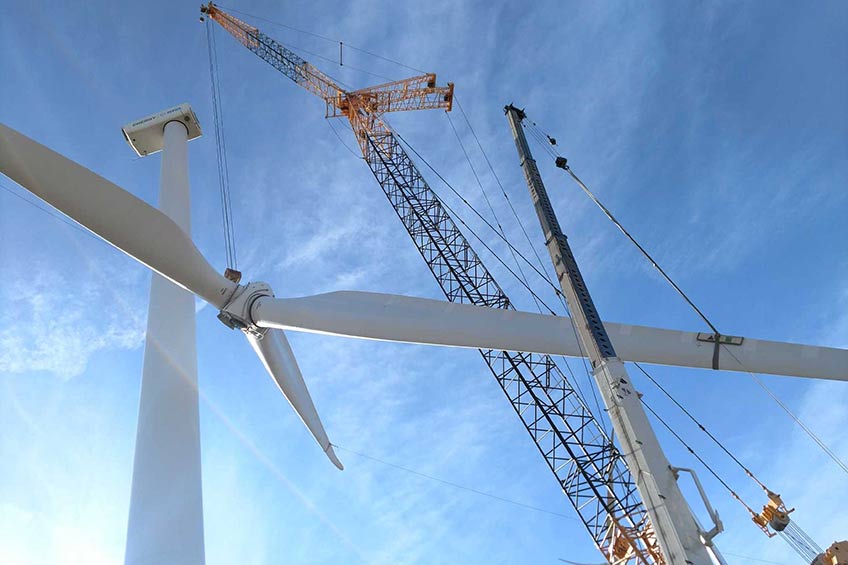Research Strengthens Reliability as Wind Power Shifts Into High Gear

Removing a rotor to swap out a gearbox such as this one at the National Wind Technology Center at NREL can be a complex and expensive undertaking. Photo by Brad King, RENEW Energy Maintenance
Wind energy is shifting into high gear. According to the American Clean Power Association, more than 60,000 wind turbines were in operation across the United States at the end of 2020, providing 7.4% of the nation’s electricity, more than any other renewable energy source.
Some of the most vital and heavily used components—which account for as much as 11% of overall wind turbine cost—are gearboxes. Gearboxes convert low-speed blade rotations to the high speeds required by most generators for electricity generation. Keeping these gearboxes in operating condition is essential to efficient and cost-effective wind power plant operation.
New tools from the U.S. Department of Energy’s (DOE’s) National Renewable Energy Laboratory (NREL) are making it possible to predict individual component reliability for the entire wind plant, reduce operations and maintenance costs through early design decisions, and take maintenance measures to extend gearbox life spans.
Gearboxes are designed to last for 20 years or more but can require repeated repairs or early replacement if problems are not caught in time. High-speed-shaft bearings inside a gearbox tend to be the most common source of breakdowns. They are crucial to reducing friction and distributing loads for efficient and smooth gearbox operation. Cylindrical roller bearings (CRBs) and tapered roller bearings (TRBs) are two common types of bearings used in wind turbine gearboxes.
NREL has developed modeling software that allows operators and designers to more effectively assess and proactively address potential bearing failures. Existing design standards and models do not account for the prevalence of gearbox failures, and condition monitoring systems only identify damage after it has already occurred. A partnership with wind plant optimization specialist WindESCo will make it possible to evaluate and speed up commercialization of the NREL tools based on data and expertise from real-world wind plant operations.
“Identifying issues before they interrupt turbine operation makes it possible to reduce the frequency and severity of actual breakdowns,” said NREL Senior Research Engineer Shawn Sheng, who is a principal investigator on the project. “This eventually can deliver cost savings as well as increase turbine uptime and life span.”
Although the NREL project originally focused exclusively on CRBs, researchers soon realized that comparable issues with TRBs called for the development of additional models. NREL’s new TRB model will benefit current and future gearbox configurations, as TRB popularity continues to grow due to the tapered bearings’ ability to carry greater thrust loads and increased power density at a smaller size than more conventional CRBs.
Initial experiments conducted by Argonne National Laboratory used benchtop tests to pinpoint triggers for cracks in bearing steel, including factors such as sliding between the roller and inner ring, load, speed, lubrication, and temperature. Based on that work, NREL and its partners in the DOE-funded Drivetrain Reliability Collaborative created a physics-based methodology to calculate probability of failure using historic supervisory control and data acquisition (SCADA) data along with maintenance and failure records from actual wind plants.
“Partnering with DOE and NREL in collaboration with select customers, we are able to see how these tools perform in actual applications and guide the development toward addressing the most pressing challenges,” said WindESCo Chief Technology Officer Nathan Post.
Researchers are now adapting this methodology to assess the reliability and remaining useful life of TRBs. Eventually, these tools will allow designers and operators to predict reliability of individual components for wind plants of all types and sizes while taking design parameters, operation strategies, and control objectives into consideration.
“Shifting the conversation from diagnostics to prognostics not only helps individual wind plant operators,” Sheng said. “If you consider that operation and maintenance expenses can account for as much as 30% of a wind plant’s entire life-cycle cost, you realize how these models can encourage growth in the industry as a whole, reducing risk and stimulating investment.”
The CRB and TRB modeling tools have been awarded software records and will be available for licensing.
Development of the CRB models and the overarching probability of failure methodology was made possible by DOE’s Wind Energy Technologies Office, and TRB models through the Office of Technology Transitions Technology Commercialization Fund (TCF), which advances the commercialization of promising energy technologies and strengthens partnerships between national laboratories and private sector companies to deploy technologies in the marketplace.
Contact Shawn Sheng for more information on licensing these modeling tools. Learn more about NREL’s wind power reliability research, its leadership of the Drivetrain Reliability Collaborative, and earlier CRB research.
Last Updated May 28, 2025
